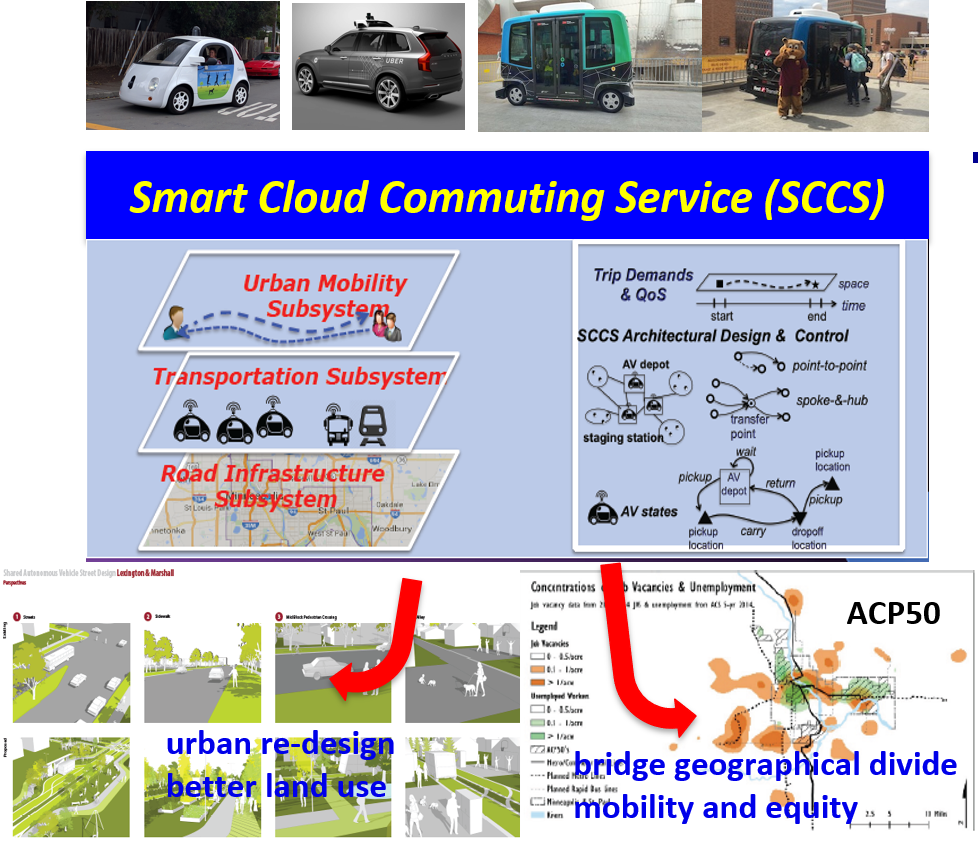OverviewPeoplePublicationsDatasets and Other Artifacts

Transportation plays a critical role in connecting people to where they want to be (“destinations”) – offices, schools, hospitals, restaurants, movie theaters, among others. The geographical mismatch between where people live and where various opportunities (e.g., job, education, healthcare, entertainment) are located, coupled with no or limited transportation means, contribute to inequalities in income, education, health, and social mobility. In particular, transportation policy efforts in the U.S. have historically prioritized system efficiency goals and overlooked efficiency-equity tradeoffs, resulting in polarized private and public transport options that reinforce social segregation and inequities. On the one hand, private transport has dominated the U.S. transportation system to the degree that system efficiency is best served by the allocation of resources to the private transportation sector. On the other hand, the lack of investments in the public transportation sector has made public transit an inferior alternative that only consumers who cannot afford private car ownership would choose.
Emerging autonomous vehicles (“driverless cars”), together with mobile and sensing technologies and the “Internet-of-Things,” offer the potential to transform future – both public and private – transportation services. However, these new technologies by themselves will not solve many of the social, economic, and operational issues plaguing the existing transportation systems. Autonomous vehicles (AVs) may in fact further widen the economic disparity, among those who can afford to own private AVs and those who cannot. How can we leverage the emerging AVs to re-think and re-design future transportation services to enable smart and connected communities where everyone benefits – especially by breaking the vicious cycle of underserving and marginalizing the mobility needs of the socioeconomically disadvantaged? How can “citizen science” (i.e., public participation in scientific research via various means and forms) be leveraged to identify disparities in mobility needs and generate future-oriented transport solutions that are mutually satisfying across diverse communities?
In this project, we envisage a forward-looking, ambitious and disruptive smart cloud commuting system (SCCS) for future smart communities based on emerging connected, autonomous vehicles. Employing pools of shared AVs of varying sizes (from passenger cars to vans, shuttles and buses), this smart cloud commuting system seeks to replace, complement, and integrate various modes of transport – personal vehicles, public buses, and taxis, used in today’s private and public transport systems – in a unified, on-demand fashion, providing passengers of all socioeconomic strata with a fast, convenient, affordable and multimodal mobility service. In order to make the envisaged SCCS as convenient and responsive as personal cars while at the same time as inexpensive as possible, we leverage economies-of-scale: we aim to employ giant pools of shared AVs that will be used to serve the mobility demands of (nearly) all users in a large urban city or metro area. Namely, unlike most of today’s ride-hailing or car-sharing services such as Uber, Lyft, Zipcar, or car2go, our envisaged SCCS will be designed not only to serve users’ occasional, ad hoc trips, but primarily also to meet users’ daily commuting needs.
Our research is organized along four integrative research thrusts/tasks. In Trust 1. Data-driven Demand Analysis: Quantifying System Efficiency Gains, we will employ real-world travel demand datasets to tackle the fundamental research challenge– what and how much gain can be attained through cloud commuting via shared AVs – by obtaining theoretical bounds on the number of AVs needed to serve a large user population and analyzing the levels of QoS that can be delivered to users under various scenarios. In Trust 2. Quantifying Architectural Design Choices and Operational Challenges, we will address various research challenges – including SCCS system architectures – in designing SCCS with the coverage, convenience and QoS to meet user expectations, and investigate various practical operational issues and trade-offs involved by developing traffic flow models and comprehensive simulation-based evaluation frameworks. In Trust 3. Economic Viability: SCCS Business Models and Equity-Efficiency Trade-offs, we will study the cost-effectiveness, economic viability and efficiency-equity tradeoffs of SCCS through modeling and analysis of AV ownership options and market structures as well as service options, user choices, geographical locations, income levels and other socioeconomic factors. Last but not the least, in Trust 4. Understanding Social Impacts of SCCS, we will study the social impacts of AVs on diverse communities, urban re-design and land use issues, and in particular, how to leverage SCCS to bring equal economic and other opportunities to disadvantaged communities. In carrying out the proposed research, we will work with our community partners at various levels and conduct several pilot projects as focused case studies to apply, test and evaluate the research outcomes.
